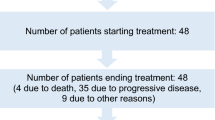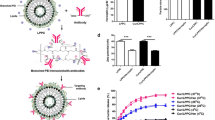Abstract
Purpose
The antitumor effect of paclitaxel-loaded PEGylated immunoliposome (PILs) was investigated in breast cancer cell lines and the xenograft model.
Methods
Herceptin was conjugated to paclitaxel-loaded PEGylated liposomes (PLs). In vitro cellular uptake and cytotoxicity of PILs were determined in breast cancer cell lines while in vivo antitumor efficacy was evaluated in the xenograft nude mouse model.
Results
The PILs formulation was able to significantly increase the HER2 mediated cellular uptake of paclitaxel compared to the PLs in cell lines overexpressing HER2 (BT-474 and SK-BR-3 cells). However, in the MDA-MB-231 cells, which express low levels of HER2, the difference between the PILs and PLs formulation was not significant. The biological activity of Herceptin was maintained throughout the conjugation process as exhibited by the antitumor dose–response curves determined for Herceptin itself, for the thiolated Herceptin alone and subsequently for the immunoliposome-coupled Herceptin. In BT-474 and SK-BR-3 cells, the cytotoxicity of the PILs was more potent than that of Taxol. Moreover, in in vivo studies, PILs showed significantly higher tumor tissue distribution of paclitaxel in the BT-474 xenograft model and more superior antitumor efficacy compared to Taxol and PLs. However, in the MDA-MB-231 xenograft model, PILs and PLs showed similar tumor tissue distribution as well as antitumor activity.
Conclusions
These results suggest that HER2-mediated endocytosis is involved in the PILs formulation. The ability of the PILs formulation to efficiently and specifically deliver paclitaxel to the HER2-overexpressing cancer cells implies that it is a promising strategy for tumor-specific therapy for HER2-overexpressing breast cancers.





Similar content being viewed by others
Abbreviations
- CHOL:
-
cholesterol
- DMEM:
-
Dulbecco’s modified eagle medium
- EPR:
-
enhanced permeability and retention
- FBS:
-
fetal bovine serum
- HER2:
-
human epidermal growth factor receptor-2
- MEM:
-
minimum essential medium
- MPEG2000-DSPE:
-
1,2-distearoyl-sn-glycero-3-phosphoethanolamine [methoxy(polyethyleneglycol)-2000]
- MTT:
-
3-(4,5-dimethylthiazol-2-ly)– 2,5-diphenyl-tetrazolium bromide
- PBS:
-
phosphate-buffered saline
- PEG:
-
polyethylene glycol
- PILs:
-
PEGylated immunoliposomes
- PLs:
-
PEGylated liposomes
- S100PC:
-
soybean phosphatidylcholine
- Rh-PE:
-
rhodamine labeled-phosphatidylethanolamine
References
T. Yamamoto, S. Ikawa, T. Akiyama, K. Semba, N. Nomura, N. Miyajima, T. Saito, and K. Toyoshima. Similarity of protein encoded by the human c-erb-B-2 gene to epidermal growth factor receptor. Nature 319:230–240 (1986).
C. I. Bargmann, M. C. Hung, and R. A. Weinberg. The neu oncogene encodes an epidermal growth factor receptor-related protein. Nature 319:226–230 (1986).
M. Tan, J. Yao, and D. Yu. Overexpression of the c-erbB-2 gene enhanced intrinsic metastasispotential in human breast cancer cells without increasing their transformation abilities. Cancer Res. 57:1199–1205 (1997).
G. N. Hortobagyi. Treatment of breast cancer. N. Engl. J. Med. 339:974–984 (1998).
D. J. Slamon, G. M. Clark, S. G. Wong, W. J. Levin, A. Ullrich, and W. L. McGuire. Human breast cancer: correlation of relapse and survival with amplification of the HER-2/neu oncogene. Science 235:177–182 (1987).
M. Toi, K. Horiguchi, H. Bando, S. Saji, and L. W. C. Chow. Trastuzumab: updates and future issues. Cancer Chemother. Pharmacol. 56:s94–s99 (2005).
P. Carter, L. Presta, C. M. Gorman, J. B. Ridgway, D. Henner, and W. L. Wong. Humanization of an anti-p185her2 antibody for human cancer therapy. Proc. Natl. Acad. Sci. USA 89:4285–4289 (1992).
J. Baselga, D. Tripathy, J. Mendelsohn, S. Baughman, C. C. Benz, L. Dantis, N. T. Sklarin, A. D. Seidman, C. A. Hudis, J. Moore, P. P. Rosen, T. Twaddell, I. C. Henderson, and L. Norton. Phase II study of weekly intravenous recombinant humanized anti-p185HER2 monoclonal antibody in patients with HER/neu-overexpressing metastatic breast cancer. J. Clin. Oncol. 14:737–744 (1996).
M. A. Cobleigh, C. L. Vogel, D. Tripathy, N. J. Robert, S. Scholl, L. Fehrenbacher, J. M. Wolter, V. Paton, S. Shak, G. Lieberman, and D. J. Slamon. Multinational study of the efficacy and safety of humanized anti-HER2 monoclonal antibody in woman who have HER2-overexpressing metastatic breast cancer that has progressed after chemotherapy for metastatic disease. J. Clin. Oncol. 17:2639–2648 (1999).
D. J. Slamon, B. Leyland-Jones, S. Shak, H. Fuchs, V. Paton, A. Bajamonde, T. Fleming, W. Eiermann, J. Wolter, M. Pegram, J. Baselga, and L. Norton. Use of chemotherapy plus a monoclonal antibody against HER2 for metastatic breast cnacer that overexpresses HER2. N. Engl. J. Med. 344:783–792 (2001).
E. K. Rowinsky, and R. C. Donehower. Paclitaxel (Taxol). N. Engl. J. Med. 332:1004–1014 (1995).
T. M. Mekhail, and M. Markman. Paclitaxel in cancer therapy. Expert Opin. Pharmacother. 3:755–766 (2002).
A. M. Yvon, P. Wadsworth, and M. A. Jordan. Taxol suppresses dynamics of individual microtubules in living human tumor cells. Mol. Bio. Cell 10:947–959 (1999).
A. Goncalves, D. Braguer, K. Kamath, L. Martello, C. Briand, S. Horwitz, L. Wilson, and M. A. Jordan. Resistance to Taxol in lung cancer cells associated with increased microtubule dynamics. Proc. Natl. Acad. Sci. USA 98:11737–11742 (2001).
M. A. Jordan, and L. Wilson. Microtubules as a target for anticancer drugs. Nat. Rev. Cancer 4:253–265 (2004).
M. D. Pegram, A. Lopez, G. Konecny, and D. J. Slamon. Trastuzumab and chemotherapeutics: drug interactions and synergies. Semin. Oncol. 27(6 Suppl 11):21–25 (2000).
V. Dieras, P. Beuzeboc, V. Laurence, J. Y. Pierga, and P. Pouillart. Interaction between Herceptin and taxanes. Oncology 61(Suppl 2):43–49 (2001).
S. Suzuki, S. Watanabe, T. Masuko, and Y. Hashimoto. Preparation of long-circulating immunoliposomes containing adriamycin by a novel method to coat immunoliposomes with polyethylene glycol. Biochem. Biophys. Acta 1245:22–29 (1995).
S. M. Nam, H. S. Kim, W. S. Ahn, and Y. S. Park. Sterically stabilized anti-G(M3), anti-Le(x) immunoliposomes: targeting to B16BL6, HRT-18 cancer cells. Oncol. Res. 11:9–16 (1999).
G. Pagnan, P. G. Montaldo, F. Pastorino, L. Raffaghello, M. Kirchmeier, and T. M. Allen. GD2-mediated melanoma cell targeting and cytotoxicity of liposome-entrapped fenretinide. Int. J. Cancer 81:268–274 (1999).
K. R. Reddy. Controlled-release, pegylation, liposomal formulation: new mechanisms in the delivery of injectable drugs. Drug Deliv. 34:915–923 (2000).
J. W. Park, K. Hong, D. B. Kirpotin, D. Papahadjopoulos, and C. C. Benz. Immunoliposomes for cancer treatment. Adv. Pharmacol. 40:399–435 (1997).
J. S. Chen, K. L. Lan, and M. C. Hung. Strategies to target HER2/neu overexpression for cancer therapy. Drug Resist. Updat. 6:129–136 (2003).
J. W. Park, K. Hong, P. Carter, H. Asgari, L. Y. Guo, G. A. Keller, C. Wirth, R. Shalaby, C. Kotts, W. I. Wood, D. Papahadjopoulos, and C. C. Benz. Development of anti-p185HER2 immunoliposomes for cancer therapy. Proc. Natl. Acad. Sci. USA 92:1327–1331 (1995).
T. Yang, M. K. Choi, F. D. Cui, J. S. Kim, S. J. Chung, C. K. Shim, and D. D. Kim. Preparation and evaluation of paclitaxel-loaded PEGylated immunoliposome. J. Control. Release 120:169–177 (2007).
T. Yang, F. D. Cui, M. K. Choi, J. W. Cho, S. J. Chung, C. K. Shim, and D. D. Kim. Enhanced solubility and stability of PEGylated liposomal paclitaxel: in vitro and in vivo evaluation. Int. J. Pharm. 338:317–326 (2007).
U. B. Nielsen, D. B. Kirpotin, E. M. Pickering, K. Hong, J. W. Park, M. R. Shalaby, Y. Shao, C. C. Benz, and J. D. Marks. Therapeutic efficacy of anti-ErbB2 immnoliposomes targeted by a phage antibody selected for cellular endocytosis. Biochim. Biophys. Acta 1591:109–118 (2002).
C. Fonseca, J. N. Moreira, C. J. Ciudad, M. C. Pedroso de Lima, and S. Simões. Targeting of sterically stabilised pH-sensitive liposomes to human T-leukaemia cells. Eur. J. Pharm. Biopharm. 59:359–366 (2005).
K. Laginha, D. Mumbengegwi, and T. Allen. Liposomes targeted via two different antibodies: assay, B-cell binding and cytotoxicity. Biochim. Biophys. Acta 1711:25–32 (2005).
P. R. Twentyman, and M. Luscombe. A study of some variables in a tetrazolium dye (MTT) based assay for cell growth and chemosensitivity. Br. J. Cancer 56:279–285 (1987).
A. Sharma, U. S. Sharma, and R. M. Straubinger. Paclitaxel-liposomes for intracavity therapy of intraperitoneal P388 leukemia. Cancer Lett. 107:265–272 (1996).
C. X. Wang, D. C. Koay, A. Edwards, Z. Lu, G. Mor, I. T. Ocal, and M. P. DiGiovanna. In vitro and in vivo effects of combination of trastuzumab (Herceptin) and tamoxifen in breast cancer. Breast Cancer Res. Treat. 92:251–263 (2005).
N. Maeda, Y. Takeuchi, M. Takada, Y. Sadzuka, Y. Namba, and N. Oku. Anti-neovascular therapy by use of tumor neovasculature-targeted long-circulating liposome. J. Control. Release 100:41–52 (2004).
M. Owais, and C. M. Gupta. Liposome-mediated cytosolic delivery of macromolecules and its possible use in vaccine development. Eur. J. Biochem. 267:3946–3956 (2000).
S. C. Semple, A. Chonn, and P. R. Cullis. Influence of cholesterol on the association of plasma proteins with liposomes. Biochemistry 35:2521–2525 (1996).
M. C. Woodle. Controlling liposomal blood clearance by surface-grafted polymers. Adv. Drug Deliv. Rev. 32:139–152 (1998).
Y. P. Hu, N. Henry-Toulme, and J. Robert. Failure of liposomal encapsulation of doxorubicin to circumvent multidrug resistance in an in vitro model of rat glioblastroma cells. Eur. J. Cancer 31:389–394 (1995).
M. L. Immordino, P. Brusa, S. Arpicco, B. Stella, F. Dosio, and L. Cattel. Preparation, characterization, cytotoxicity and pharmacokinetics of liposomes containing decetaxel. J. Control. Release 91:417–429 (2003).
P. Crosasso, M. Ceruti, P. Brusa, S. Arpicco, and L. Cattel. Preparation, characterization and properties of sterically stabilized paclitaxel-containing liposomes. J. Control. Release 63:19–30 (2000).
P. Carter. Improving the efficacy of antibody-based cancer therapies. Nat. Rev. Cancer Nov1:118–129 (2001).
R. J. Pietras, B. M. Fendly, V. R. Chazin, M. D. Pegram, S. B. Howell, and D. J. Slamon. Antibody to HER-2/neu receptor blocks DNA repair after cisplatin in human breast and ovarian cancer cells. Oncogene 9:1829–1838 (1994).
J. Baselga, L. Norton, J. Albanell, Y. M. Kim, and J. Mendelsohn. Recombinant humanized anti-HER2 antibody (Herceptin) enhances the antitumor activity of paclitaxel and doxorubicin against HER2/neu overexpressing human breast cancer xenografts. Cancer Res. 58:2825–2831 (1998).
A. Ito, Y. Kuga, H. Honda, H. Kikkawa, A. Horiuchi, Y. Watanabe, and T. Kobayashi. Magnetic nanoparticle-loaded anti-immunoliposomes for combination of antibody therapy with hyperthermia. Cancer Lett. 212:167–175 (2004).
F. Valeriote, and H. Lin. Synergistic interaction of anticancer agents: a cellular perspective. Cancer Chemother. Rep. 59:895–900 (1975).
U. Massing, and S. Fuxius. Liposomal formulations of anticancer drugs: selectivity and effectiveness. Drug Resist. Updat. 3:171–177 (2003).
E. Mastrobattista, G. A. Koning, and G. Storm. Immunoliposomes for the targeted delivery of anticancer drugs. Adv. Drug Deliv. Rev. 40:103–127 (1999).
Acknowledgements
This research was financially supported by the Ministry of Science and Technology (M10528010004-06N2801-00410) in Korea. The authors would like to thank the Lipoid GmbH (Germany) and Genentech companies for providing phosphatidylcholine and Herceptin, respectively.
Author information
Authors and Affiliations
Corresponding author
Rights and permissions
About this article
Cite this article
Yang, T., Choi, MK., Cui, FD. et al. Antitumor Effect of Paclitaxel-Loaded PEGylated Immunoliposomes Against Human Breast Cancer Cells. Pharm Res 24, 2402–2411 (2007). https://doi.org/10.1007/s11095-007-9425-y
Received:
Accepted:
Published:
Issue Date:
DOI: https://doi.org/10.1007/s11095-007-9425-y




